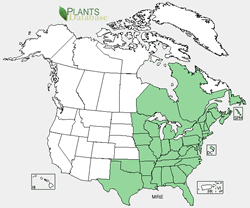Plant of the Week
 Range map of Partridge Berry. States are colored green where Partridge Berry may be found.
Range map of Partridge Berry. States are colored green where Partridge Berry may be found.
 Partridge Berry flower (Mitchella repens). Photo by T.G. Barnes, USDA NRCS PLANTS Database.
Partridge Berry flower (Mitchella repens). Photo by T.G. Barnes, USDA NRCS PLANTS Database.
 Partridge berries. Photo by Alan S. Heilman, University of Tennessee Herbarium.
Partridge berries. Photo by Alan S. Heilman, University of Tennessee Herbarium.
Partridge Berry (Mitchella repens L.)
By Larry Stritch
Partridge Berry is a member of the Madder Family (Rubiaceae). The genus name Mitchella was given to this plant by Linnaeus for his friend John Mitchell, a physician who developed a method of treating yellow fever. The species name repens refers to its trailing or creeping habit. Partridge Berry is found throughout eastern North America from Newfoundland to Ontario and Minnesota, south to Texas and Florida.
Partridge Berry is a native perennial, a small, woody, trailing vine with 6 to 12 inch, slender, trailing stems that does not climb but lays prostrate on the forest floor. The trailing stems root at nodes which come in contact with the forest surface and may spread into colonies several yards across. The dark-green, evergreen leaves are simple, opposite, ovate, with a pale yellow midrib, are ½ inch across, with a short stalk. In late spring, a pair of white flowers (with a single calyx) appears. Each small, fragrant flower has four brilliant white petals that are pubescent and unite into a funnel-shaped tube that is also fringed with hairs. The pair of flowers occur in two forms (dimorphous). In the first form the pistil is short and the stamens are long; in the second form the pistil is long and the stamens are short. This structure prevents each flower from fertilizing itself. Both flowers must be pollinated to obtain a single scarlet berry. Each berry is the result of the fusion of each ovary of the pollinated pair of white flowers. As such, each berry has two bright red spots on its surface.
Partridge berry is a fairly common inhabitant of deciduous and coniferous forests in rich organic soils with dappled sunlight to complete shade. Depending on latitude and elevation Partridge Berry flowers from late spring to early summer. Partridge Berry is pollinated by insects. The ensuing scarlet berry contains eight seeds. The fruits are tasteless and generally survive through winter and into the following spring. Birds are the primary consumer of these fruits and the subsequent distribution of seeds. Seeds require a cold stratification through the winter and some will germinate the following growing season with many seed not germinating until the second growing season.
Some gardeners consider Partridge Berry a must for winter gardens. During the cold days of late winter Partridge Berry is a treat to the eyes with its deep, dark-green leaves and occasional scarlet berries. In a garden setting this evergreen prefers shade, accepting the morning sun. Partridge Berry is extremely difficult to propagate from seed. The best way to introduce this native into your garden is through 1 year old cuttings or by division. In the garden situation they will form a thick, substantial ground cover. Once established they are relatively trouble free with the only required maintenance of keeping garden debris from covering the mats. As always, do not wild collect plants from public lands and only from private lands when the landowner grants permission. Partridge Berry is a commonly available plant from native plant nurseries especially those who specialize in woodland plants.

